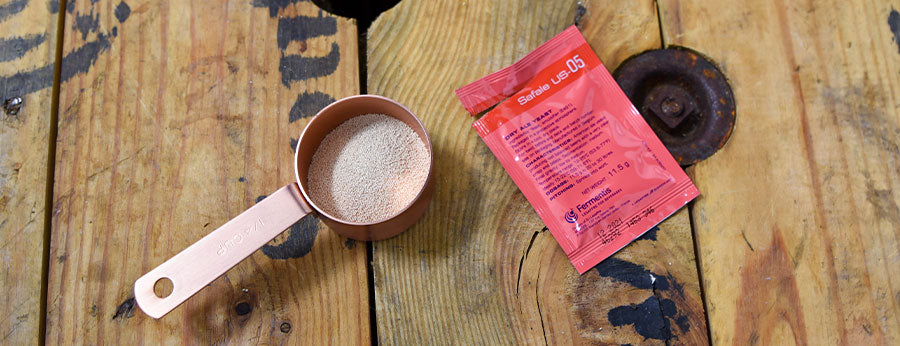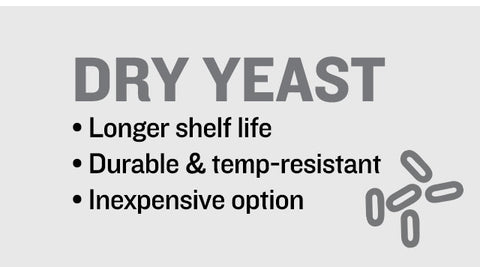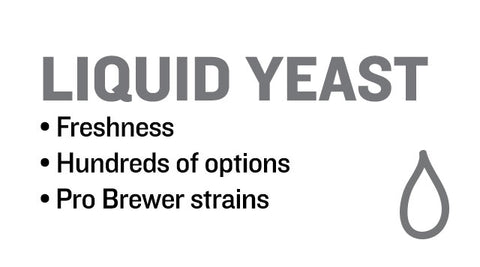August 09, 2019
Dry Yeast and Liquid Yeast

Let's unpack a common myth: liquid yeast always makes better beer.
This belief might have been true when homebrewing first began, back when using dry yeast meant dumping bootstrapped bread yeast into your wort. But no longer. Major research and advancement has overhauled what both dry and liquid yeast are capable of doing.
Both types of yeast have their advantages. The right choice for you depends entirely upon your brewing needs. Here's a quick overview of their differences:
 |
 |
Dry Yeast
Dry yeast is sterile, strain-pure, and highly capable of producing great beer. It has a shelf life of up to 3 years and is more tolerant than liquid yeast of warm storage or shipping conditions. Dry yeast is also packaged with nutrient reserves and ready to pitch without a yeast starter.
On the flip side, not all yeast strains can be dried, so there are fewer options to choose from. That's where liquid yeast comes into play.
Produced by Fermentis, a visionary leader in all things fermented, this line of dry yeast pouches are one of the most popular options for easy brewing. Think of Safale as your all-purpose flour.
Lallemand, another esteemed yeast producer, carries the Danstar yeast line. They carry a wide variety of yeast for your next beer style, but by far the most popular option is the Nottingham Ale yeast, a neutral ale strain with excellent attenuation.
Speaking of Lallemand - they recently released WildBrew™ Sour Pitch, a dry version of the lactic acid bacteria that brewers use to sour. This pouch is the first of its kind, and it marks a huge leap forward for homebrewers. Traditionally, souring was a feral, intimidating process. No longer.
And guess what? You can only get it here.
Fermentis pushes boundaries, too. Their patented Easy to Use (E2U™) dry yeasts require zero rehydration or acclimatization prior to pitching, a fabulous simplification of yeast prep. A brewer's time is precious, after all.
Note: For high gravity fermentations, more than one pack of dry yeast should be used.
Liquid Yeast
The range of available strains is the greatest benefit of liquid yeast. Any strain can be collected and cultured for use by homebrewers. However, it is most viable immediately after culturing, and viability decreases as time goes on. Therefore, brewers need to be aware of temperature.
However, because liquid yeast is a live culture, it is usually more expensive and is much more perishable. Yeast shipped by mail order usually has a practical shelf life of 3 months (sometimes longer) and can be adversely affected or destroyed by temperatures above 90 F.
When brewing with liquid yeast, keep cell count in mind. Each yeast supplier varies in packaging and cell count, so make sure you do your research before brewing. Check out this article on how to boost yeast health.
Wyeast has been producing yeast for over 30 years, they've stood at the forefront of the craft beer revolution. They're known for their "smack packs," special pouches that deliver enhanced yeast viability with just a slap of the hand.
White Labs provided a large yeast innovation in 2017. White Labs continues to astound the brewing world with PurePitch® and FlexCell™ packaging which produce the purest yeast available. The packaging allows the yeast to be grown and pitched out of the same package. At around 100 billion cells per package, they guarantee the very highest purity possible for your beer.
Focused on providing innovation in different strains, Omega Yeast prides itself on prioritizing the customer. They also know how to flex their creative muscles; last year, for example, they released a line of liquid yeasts astoundingly resistant to high temperatures. They're a true godsend in the summer months.
The only brand certified USDA Organic, Imperial Yeast is the newest kid on the block. But in their case, young doesn't mean inexperienced. Imperial's famous Pitch Right pouches contain 200 billion fresh yeast cells--the highest count in the entire industry. Imperial is our brewmasters' recommendation because of the extremely fast, vigorous start to fermentation.
Read More About Yeast:
Yeast For Brewing Beer - So what is brewing yeast anyway?
Yeast Nutrients And Yeast Energizers - Keep your yeast healthy.
Making A Yeast Starter - Learn how to make a yeast starter.
Hydrating Dry Yeast - Is pitching dry yeast directly the best method?
5 Easy Tricks For Boosting Yeast Health
